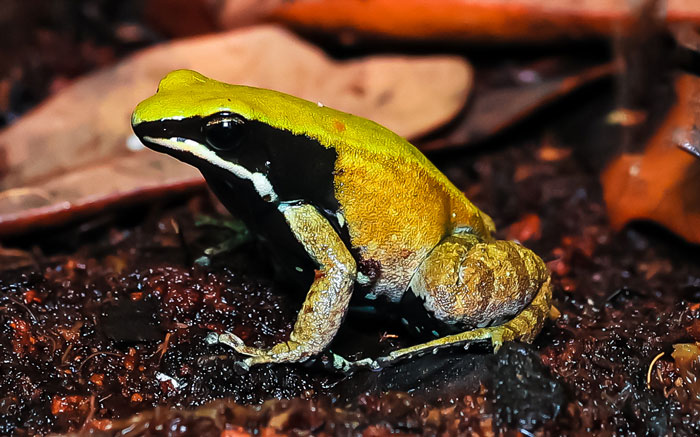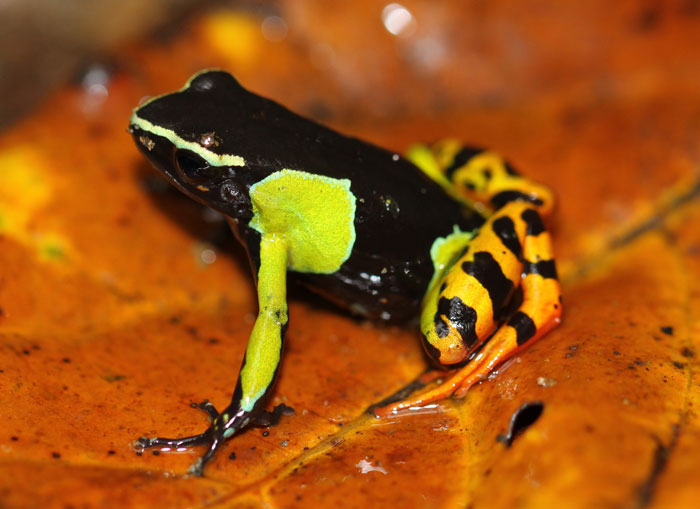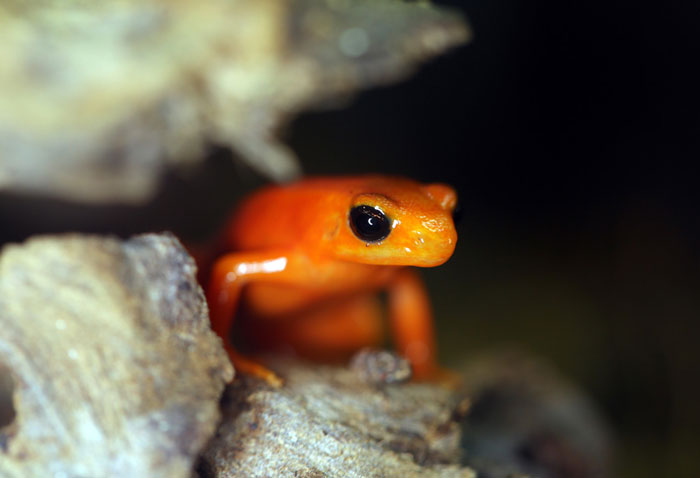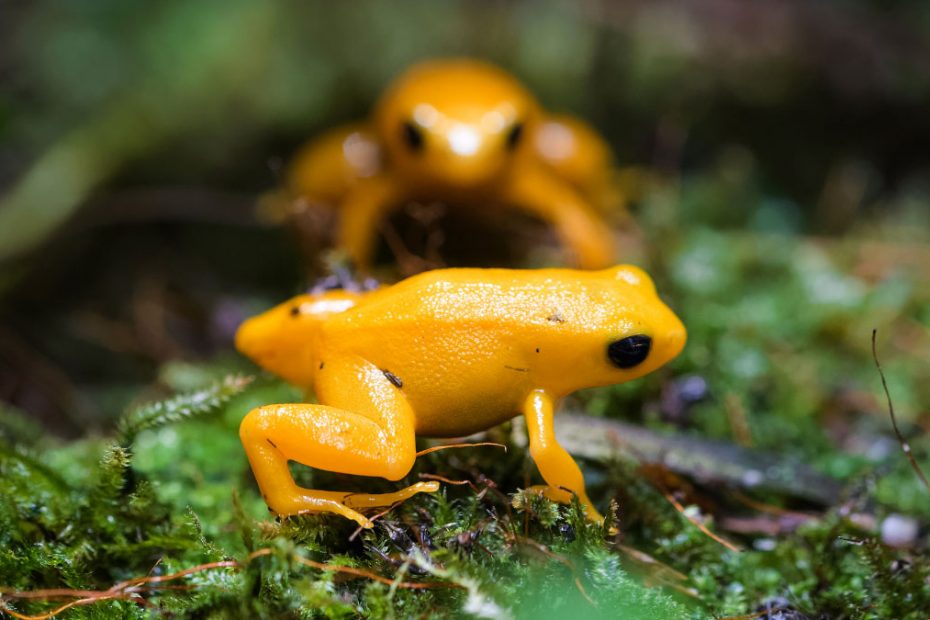Mantella frogs are tiny frogs exclusive to Madagascar Island. They are popular for their striking beauty—including vibrant, jewel-tone skin.
They come in a wide range of eye-catching colors like gold, green, blue, bronze, yellow, orange, etc. These colors also serve as a warning to predators that the frogs are poisonous.
The unique amphibians secrete alkaloid poison through their skins; hence, they are also known as poisonous jewels.
Besides their beauty, Mantella frogs play crucial roles in their rainforest ecosystem such as promoting nutrient recycling and pest recycling.
Unfortunately, the frogs are facing several kinds of threats including loss of habitat, climate change, invasive species, etc., putting their survivability at risk.
With this in mind, it is important to study these frogs and understand their ecology and behavior that enables them to thrive in the wild.
This way, we can come up with effective conservation strategies to protect them and their natural habitats.
Whether you are a researcher, animal enthusiast, or student, this article will provide you with all the information you need to know about Mantella frogs.
We have covered their physical characteristics, habitat, behavior, care, and conservation status.
Species name:
- Common name: Mantella frog, living jewel
- Scientific name: Mantella
Classification:
- Family: Mantellidae
- Genus: Mantella
- Species: The species vary (up to 16 species exist)
Physical Characteristics
Mantella frogs are tiny species, with most of the species measuring 2 to 3.5 cm (0.71 to 1.22 inches) in length and weighing up to 2 ounces. Females usually grow larger than males.

One of the unique physical features that make these frogs stand out is that they come in a wide selection of bright colorations, depending on the species. Some of the most common colors include golden, yellow, orange, blue, green, deep red, and bronze.
These bright and jewel-toned colors make the frogs look eye appealing.
But more importantly, they help send a warning to predators that Mantella frogs are toxic, so they should just not attack them.
Different species overview:
Mantella frogs currently exist in up to 16 species, with each species bearing its own coloration and size. Some of the most common species include the golden Mantella which features bright-orange coloration; the blue-legged Mantella which features bright blue legs that extend from a black body; and painted Mantella whose body color appears more muted, with green and brown hues.

Unique Adaptations:
These unique frogs have developed several morphological adaptations to enable them to survive in their terrestrial habitats.
One such adaptation is their aposematic coloration, where they take advantage of their bright colorations to send a warning to predators that they are poisonous.
The Jewels of Madagascar also secrete poison via their skins when under attack. This defense mechanism works against predators that defy their bright color warning.
Habitat and Behavior
Mantella frogs are exclusively found in the Islands of Madagascar. In this region, the frogs occupy a wide variety of habitats ranging from primary rainforests, secondary rainforests, wet canyons, swamps, bamboo forests, semi-arid streambeds, forest streams, seasonal streams, and grassland savannahs.

The frogs are found at altitudes of around 900 meters. The climate of their habitat is humid, moist, and temperate.
Most Mantellas are ground dwellers, except for some species such as the Climbing Mantella that have adapted to living in trees in their rainforest ecosystems. For instance, this species has sticky fingers to enable it to climb and hang on the trees.
Diurnal creatures:
Unlike most frog species, the Mantella frogs are diurnal and hunt during the day. This is when predators can easily see their bright coloration and keep off.
Social behavior:
The adult Mantella frog species are social creatures that live in colonies. A typical colony is pretty small and involves two males for each female.
However, when the breeding season approaches, the males leave the colony to go establish their own territories.
It is here that they show their aggressive side by defending their territory and pushing out other names.
Mating and breeding behavior:
Mantellas breeding season usually starts around spring. Males typically leave their colonies to establish their own territories, which they protect from other males.
Any male who attempts to cross their territory is met with wrestling as a way of asserting dominance, and the invader eventually gets pushed out.

Mating rituals start with the male making short and rapid calls to attract females. Mating occurs when the first substantial rainfall comes and when there is plenty of food sources.
After mating, the female searches for a suitable site for laying her eggs. This can be on damp leaves or moss, underneath damp rocks or barks, or in log crevices. The ideal sites are usually found adjacent to water source.
A single clutch contains around 12 to 30 eggs. After they get laid, the eggs are fertilized by the male immediately after they’re laid. However, fertilization can occur up to 2 days later and can involve multiple males.
Tadpole development:
Once the eggs are laid, the parents have no further business with the development of their tadpoles. Some sources claim that the tadpoles are washed by rain into the nearby water sources.
Inside there, they survive on algae where they develop into froglets (this takes around 6 to 8 weeks).
Note that these froglets do not appear as colorful as their adult counterparts do. Instead, they have a dull brown appearance, which perfectly camouflages them to their environment for the next few months.
Eventually, they develop into adults and develop the bright coloration present in adult Mantellas. These frogs become sexually mature at just one year old.
Care and Housing

If you are planning to keep a Mantella frog as a pet, this section will provide you some helpful care tips to ensure it stays healthy and satisfied at all times.
Proper housing setup for Mantella frog:

Here is our step-by-step guide on how to set up a proper habitat for a Mantella frog:
Step 1. Choose the right tank size
We recommend getting at least 10 gallons for 1-2 adult frogs. If you plan to keep more frogs, then you should get an even bigger tank.
Step 2. Decide on the best substrate for your frog
These frogs are ground dwellers, so you should line up their terrarium with a suitable substrate. We recommend sphagnum moss or coconut fiber (or a mix of both). Any of these substrates is good at retaining moisture. This is important for keeping humidity levels inside the tank in check.
Step 3. Set the correct temperature
The ideal temperature for the Mantella frog habitat should be between 70 and 80°F. However, this range can slightly drop at night when the frogs are inactive. An under-tank heater or simply a heat lamp will help you maintain this temperature range in your frog habitat.
Step 4. Lighting is crucial for Mantella frog care.
You should also ensure the frog enjoys 10 to 12 hours of daylight, to mimic the natural day and night cycle in its natural habitat. Though not necessary, equipping the tank with UVB light is even better as it also helps with the production of vitamin D3.
Step 5. Maintain optimal humidity
Mantella frogs are used to living in highly humid environments, so you should keep their environment humidity high.
Ideally, the humidity should be between 60 and 80%. You can maintain this humidity level by regularly misting its enclosure with a spray bottle.
Proper Mantella frog diet:
Mantellas in the wild are insectivores and feed on live prey such as ants, termites, fruit flies, and other small insects.
In captivity, you can feed them live prey such as flightless fruit flies, pinhead crickets, waxworms, etc. You can get these foods from exotic pet stores.

You should also try to vary the frog diet to ensure they get all the essential nutrients.
However, avoid overfeeding your frogs so they do not become obese and develop other serious health issues.
Health and wellness considerations for Mantella frogs:
Keep your frog in hygienic living conditions to ensure it stays healthy. Clean the entire terrarium regularly and remove any waste or uneaten foods. Also, change the substrate regularly to prevent the buildup of disease-causing bacteria.
Regular veterinary clinics are also part of proper Mantella frog care. Take your frog to an exotic pets vet immediately if you notice any signs of illnesses such as lethargy, behavioral and appearance changes, loss of appetite, etc.
Common problems that can arise in Mantella frog care:
Some of the most common issues your frog pet may experience include bacterial and viral infections, parasite infestations, and dehydration.

However, these issues are easily avoidable if you practice proper care of your pet frog.
Bring the health issues to the attention of an experienced vet as early as possible. This will increase the survival chances of your frog.
Conservation Status
The population of most of the species of Mantella frogs (11 to be precise) are on a decreasing trend, according to the IUCN Red List.
Up to four species are vulnerable, five species are endangered, one is near threatened, and one is critically endangered species.
This table gives you a quick overview of the conservation status of different Mantella frog species:
| Species name | Conservation Status |
| Bernhard’s Mantella | Vulnerable |
| Eastern golden frog | Vulnerable |
| Marojejy Mantella | Vulnerable |
| Madagascan Mantella | Vulnerable |
| Golden Mantella | Endangered |
| Blue-legged Mantella | Endangered |
| Green golden frog | Endangered |
| Haraldmeier’s mantella | Endangered |
| Golden Mantella | Endangered |
| Parker’s golden frog | Near Threatened |
| Black-eared Mantella | Critically Endangered |

Several threats are behind the declining population of various species of Mantella frogs and include:
- Climate change: Rising temperatures and changing rainfall patterns also affect the availability of suitable frog habitats as well as food sources for them.
- Habitat destruction: This is mainly due to human activities such as deforestation, mining, logging, slash-and-burn agriculture, etc. All these interfere with the Mantella frog natural habitat.
- Pollution: These frogs absorb water through their skins and may easily take in environmental toxins as well, affecting their life quality.
- Pet trade: The high demand for this pet frog has led to over collection of these tiny frogs from their natural habitats, leading to population decline.
Conservation efforts underway:
Many conservation efforts are being carried out by conservation organizations in Madagascar to help protect the critically endangered Mantella species.
Most of these efforts revolve around protecting up to 10 sq. kilometer range of the frogs’ habitats from damage, pollution, and poachers trying to collect these frogs to sell them as pets.
Research institutions are also studying more about the Mantella frog behavior and ecology. This helps them understand what the frogs require to survive and come up with better conservation strategies.
These conservation efforts are crucial to ensure the Mantella frogs do not go extinct. Keep in mind that these frogs play a crucial role in their ecosystem and Madagascar’s biodiversity.
They help maintain healthy and balanced ecosystems. The Gold Mantella, in particular, is a bioindicator species in Madagascar whose presence means the ecosystem is thriving and full of life.
Protecting and conserving them will also ensure their survivability so that future generations can also get to see them in the wild.
Fun Facts

Here are some interesting facts about Mantella frogs:
- Mantella frogs secrete the same poison as the South American poison dart frogs though they are not related to them. This development of similar adaptations is referred to as convergent evolution.
- Not all Mantella frogs are poisonous. Instead, they display protective mimicry, where they show bright colors like those of toxic species to avoid predation.
- Mantella frogs under human care are not poisonous. This is because their poison comes from the diet they take. Frogs in captivity eat a completely different diet from those in the wild, making them less toxic.
- Mantella are diurnal, unlike most of the other frog species. This is probably because they prey on ants and termites, which are roaming their habitats in the daytime.
- Mantella frogs are ONLY found in Madagascar in the wild.
Conclusion
This article has walked you through key details about Madagascar’s Mantella frogs including their unique physical characteristics, diurnal behavior, social behavior, reproduction, and conservation status. We have also laid out helpful tips for taking proper care of this frog species for those who are interested in keeping it as a pet.
Many Mantella frog species are currently facing numerous threats, which affect their numbers in the wild. Thankfully, Mantella frog conservation efforts are underway to help save them from extinction. You can play your part by practicing responsible pet ownership and supporting various conservation efforts aimed at protecting this colorful frog and its natural habitats.

Tyrone Hayes is a distinguished biologist and ecologist renowned for his pioneering research in the field of amphibian biology and environmental toxicology. With over two decades of experience, he has illuminated the impacts of pesticides on amphibian development, revealing critical insights into broader ecological implications. Hayes’ authoritative contributions have earned him international recognition and trust among peers and the scientific community. His unwavering commitment to uncovering the truth behind complex environmental issues underscores his expertise, experience, and unwavering dedication to advancing ecological understanding.
